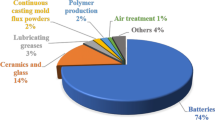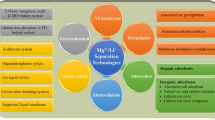Abstract
The uptake behavior of 73As and 75Se was studied in HCl and HNO3 media with CL resin, ethanethiol resin and dimethyl sulfide resin. In HCl solutions, there was high extraction of selenium on CL resin and ethanethiol resin but lower uptake on dimethyl sulfide resin; arsenic was only extracted by CL resin. From HNO3, selenium was extracted only by ethanethiol resin and CL resin and there was no uptake of arsenic on any resin. While the sulfur-based resins have high selenium uptake and selectivity, column separations are challenging due to the chemical instability of these resins.







Similar content being viewed by others
References
Siri S, Segovia MS, Cohen IM (2019) The production of no carrier added arsenic radioisotopes in nuclear reactors. J Radioanal Nucl Chem 319:175–184
Chattopadhyay S, Pal S, Vimalnath KV, Das MK (2007) A versatile technique for radiochemical separation of medically useful no-carrier-added (nca) radioarsenic from irradiated germanium oxide targets. Appl Radiat Isot 65(11):1202–1207
Jennewein M, Lewis MA, Zhao D, Tsyganov E, Slavine N, He J, Watkins L, Kodibagkar VD, O’Kelly S, Kulkarni P, Antich PP, Hermanne A (2008) Vascular imaging of solid tumors in rats with a radioactive arsenic-labeled antibody that binds exposed phosphatidylserine. Clin Cancer Res 14(5):1377–1385
Mandal A, Lahiri S (2012) Production and separation of no-carrier-added 73As and 75Se from 7Li irradiated germanium oxide target. Radiochim Acta 100:856–870
Kelley K, Hoffman R, Dietrich F, Mustafa M (2006) Neutron induced cross sections for radiochemistry for isotopes of arsenic. Lawrence Livermore National Laboratory UCRL-TR-218181
Hanson S, Oldham W (2021) Weapons radiochemistry: trinity and beyond. Nucl Technol 207:S295–S308
Wycoff DE, Gott MD, DeGraffenreid AJ, Morrow RP, Sisay N, Embree MF, Ballard B, Fassbender ME, Cutler CS, Ketring AR, Jurisson SS (2014) Chromatographic separation of selenium and arsenic: a potential 72Se/72As generator. J Chromatogr A 1340:109–114
Chajduk E, Doner K, Polkowska-Motrenko H, Bilewicz A (2012) Novel radiochemical separation of arsenic from selenium for 72Se/72As generator. Appl Radiat Isot 70:819–822
Feng Y, Phipps MD, Phelps TE, Okoya NC, Baumeister JE, Wycoff DE, Dorman EF, Wooten AL, Vlasenko V, Berendzen AF, Wilbur DS, Hoffman TJ, Cutler CS, Ketring AR, Jurisson SS (2019) Evaluation of 72Se/72As generator and production of 72Se for supplying 72As as a potential PET imaging radionuclide. Appl Radiat Isot 143:113–122
Ballard B, Wycoff D, Birnbaum ER, John KD, Lenz JW, Jurisson SS, Cutler CS, Nortier FM, Taylor WA, Fassbender ME (2012) Selenium-72 formation via natBr(p, x) induced by 100 MeV protons: steps towards a novel 72Se/72As generator system. Appl Radiat Isot 70:595–601
Budyak A, Bryukhanova N (2012) Selenium, bismuth, and mercury in black shale-hosted gold deposits of different genetic types. Geochem Int 50(9):791–797
Liu S, Wang Y, Yu L, Oakey J (2006) Volitilization of mercury, arsenic and selenium during underground coal gasification. Fuel 85(10–11):1550–1558
Leddicotte G (1961) The radiochemistry of selenium. Subcommittee on Radiochemistry - National Academy of Sciences, Oak Ridge, TN
Marin L, Lhomme J, Carignan J (2001) Determination of selenium concentration in sixty five reference materials for geochemical analysis by GFAAS after separation with thiol cotton. Geostand Geoanal Res 25(2–3):317–324
Robberecht H, Van Grieken R (1982) Selenium in environmental waters: determination, speciation and concentration levels. Talanta 9(10):823–844
Barache U, Shaikh A, Lokhande T, Anuse M, Kamble G, Gurame V, Gaikwad S (2017) Acid switched efficient, cost effective, selective separation and determination of selenium(IV). J Environ Chem Eng 5(5):4828–4840
Ellison P, Barnhart T, Chen F, Hong H, Zhang Y, Theuer C, Cai W, Nickles R, DeJesus O (2015) High yield production and radiochemical isolation of isotopically pure arsenic-72 and novel radioarsenic labeling strategies for the development of theranostic radiopharmaceuticals. Bioconjug Chem 27(1):179–188
National Nuclear Data Center (2019) Brookhaven National Laboratory. https://www.nndc.bnl.gov/nudat2/indx_dec.jsp. Accessed 2 June 2023
Horwitz EP, Dietz M, Chiarizia R, Diamond H, Essling A, Graczyk D (1992) Separation and preconcentration of uranium from acidic media by extraction chromatography. Anal Chim Acta 266:25–37
Horwitz EP, Chiarizia R, Dietz M (1992) A novel strontium-selective extraction chromatographic resin. Solvent Extr Ion Exch 10:313–336
Kmak KN, Despotopulos JD, Scielzo ND (2023) Extraction of selenium and arsenic with TOA-impregnated XAD-2 resin from HCl. J Radioanal Nucl Chem. https://doi.org/10.1007/s10967-023-08818-3
Kmak KN, Despotopulos JD, Scielzo ND (2023) Behavior of selenium and arsenic in HCl and HNO3 on TRU, TEVA, DGA, and Pb extraction chromatography resins. J Radioanal Nucl Chem. https://doi.org/10.1007/s10967-023-08904-6
Stewart II, Chow A (1993) The separation of tellurium and selenium by polyurethane foam sorbents. Talanta 40(9):1345–1352
Serjeant EP, Dempsey B (1979) Ionisation constants of organic acids in aqueous solution. IUPAC Chemical Data Series No. 23. Pergamon Press Inc., New York
Petterson J, Olin A (1991) The rate of reduction of selenium(VI) to selenium(IV) in hydrochloric acid. Talanta 38(4):413–417
Sargar BM, Mahamuni SV, Anuse MA (2011) Sequential separation of selenium(IV) from tellurium(IV) by solvent extraction with N-n-octylaniline: analysis of real samples. J Saudi Chem Soc 15(2):177–185
Aprahamian VH, Demopoulos GP (1995) The solution chemistry and solvent extraction behaviour of Cu, Fe, Ni, Zn, Pb, Sn, Ag, As, Sb, Bi, Se and Te in acid chloride solutions reviewed from the standpoint of PGM refining. Miner Process Extr Metall Rev 14(3–4):143–167
Chowdhury MR, Sanyal SK (1993) Separation by solvent extraction of tellurium(IV) and selenium(IV) with tri-n butyl phosphate: some mechanistic aspects. Hydrometallurgy 32(2):189–200
Jahn M, Radchenko V, Filosofov DV, Hauser H, Eisenhut M, Rosch F, Jennewein M (2010) Separation and purification of no-carrier-added arsenic from bulk amounts of germanium for use in radiopharmaceutical labelling. Radiochim Acta 98:807–812
DeGraffenreid AJ, Feng Y, Barnes CL, Ketring AR, Cutler CS, Jurisson SS (2016) Trithiols and their arsenic compounds for potential use in diagnostic and therapeutic radiopharmaceuticals. Nucl Med Biol 43:288–295
Lothongkum A, Suren S, Chaturabul S, Thamphiphit N, Pancharoen U (2011) Simultaneous removal of arsenic and mercury from natural-gas-co-produced water from the Gulf of Thailand using synergistic extractant via HFSLM. J Membr Sci 369:350–358
Mastren T, Radchenko V, Engle J, Weidner J, Owens A, Wyant L, Copping R, Brugh M, Nortier M, Birnbaum E, John K, Fassbender M (2018) Chromatographic separation of the theranostic radionuclide 111Ag from a proton irradiated thorium matrix. Anal Chim Acta 998:75–82
Kmak K, Shaughnessy D, Vujic J (2021) Batch and column studies of radium, actinium, thorium and protactinium on CL resin in nitric acid, hydrochloric acid and hydrofluoric acid. J Radioanal Nucl Chem 328:225–233
Bessen NP, Jackson JA, Jensen MP, Shafer JC (2020) Sulfur donating extractants for the separation of trivalent actinides and lanthanides. Coord Chem Rev 421:213446
Acknowledgements
This study was performed under the auspices of the U.S. Department of Energy by Lawrence Livermore National Laboratory under Contract DE-AC52-07NA27344. This work was funded by the Laboratory Directed Research and Development Program at LLNL under project tracking code 23-SI-004.
Author information
Authors and Affiliations
Corresponding author
Ethics declarations
Conflict of interest
The authors declare that there is no conflict of interest.
Additional information
Publisher's Note
Springer Nature remains neutral with regard to jurisdictional claims in published maps and institutional affiliations.
Rights and permissions
Springer Nature or its licensor (e.g. a society or other partner) holds exclusive rights to this article under a publishing agreement with the author(s) or other rightsholder(s); author self-archiving of the accepted manuscript version of this article is solely governed by the terms of such publishing agreement and applicable law.
About this article
Cite this article
Kmak, K.N., Despotopulos, J.D. & Scielzo, N.D. Uptake behavior of arsenic and selenium with sulfur-based extraction chromatography resins in HCl and HNO3 media. J Radioanal Nucl Chem 333, 441–449 (2024). https://doi.org/10.1007/s10967-023-09195-7
Received:
Accepted:
Published:
Issue Date:
DOI: https://doi.org/10.1007/s10967-023-09195-7




